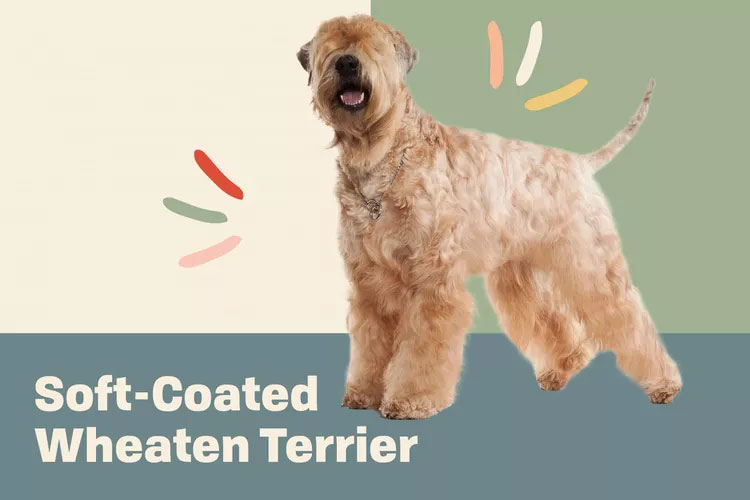
Soft-Coated Wheaten Terrier Overview
| OFFICIAL NAME | Soft-Coated Wheaten Terrier |
| COMMON NAME | Soft-Coated Wheaten Terrier |
| PET HEIGHT | 17 to 19 inches |
| PET WEIGHT | 30 to 40 pounds |
| LIFESPAN | 12 to 15 years |
| GOOD WITH | cats, children, dogs, families |
| TEMPERAMENT | friendly, outgoing, playful, willful |
| INTELLIGENCE | high |
| SHEDDING AMOUNT | infrequent |
| EXERCISE NEEDS | high |
| ENERGY LEVEL | hyper |
| VOCAL LEVEL | frequent |
| DROOL AMOUNT | low |
| BREED GROUP | terrier |
| BREED SIZE | medium (26-60 lbs.) |
| COAT LENGTH | curly, medium |
| COLORS | cream, fawn, gold / yellow |
| PATTERNS | bicolor, saddle / blanket |
| OTHER TRAITS | apartment-friendly, high prey drive, hypoallergenic, requires lots of grooming |
Spunky and sociable, the soft-coated wheaten terrier is quick to befriend and is always ready for a playful romp in the park. Traditionally bred as a worker dog on Irish farms, a wheaten terrier would typically spend their days hunting small game and vermin, herding, or working as a dutiful watch dog. Because of their background, they're highly active dogs known for their joyful personality—which shows itself in bouncing up and down when they're feeling especially happy or energetic.
This energetic nature and natural prey drive means soft-coated wheaten terriers might be best suited for active families who are experienced dog owners. A wheaten's dream home would be alongside a human with a regular exercise routine who will dedicate time to consistent training.
Aside from the wheaten terriers' fun-loving and spunky personality, they're also widely known for their silky, soft, beautiful coats—but beauty takes effort, and frequent grooming is a must. But if you're able to commit to the grooming and attention they require, they'll repay you with their playful and loving nature!
Appearance
Soft-coated wheaten terriers have an eye-catching coat that's fitting of their larger-than-life personality. They sport a trademark wisp of hair over their eyes, giving them a cartoonish look you'll fall in love with. Although wheatens have a lot of hair, they actually don't shed much, so you won't be breaking out the vacuum every day. While there's actually no such thing as a hypoallergenic dog, wheaten terriers are single-coated and produce less dander than many other breeds, so they can be a good fit for an owner prone to allergies.
They aren't called "soft-coated" for nothing—these dogs have a silky smooth coat that cascades over their body in gentle waves. Some wheatens may have a coat that veers a little more on the curly side, giving them a cuddly, almost stuffed-animal-like look. Coat colors range in various shades of wheat (hence the name "wheaten") and can be any shade from a pale beige to a shimmering dark gold. Soft-coated wheaten terrier puppies are typically born with straight hair and darker coats that lighten and curl over time as they age—in fact, their "true" color and texture typically doesn't develop until they reach two years old. Once their coats have developed, if you take a close look, you may notice bits of red, white, or even black hair hiding within the wheat.
As their full, long locks suggest, wheaten terriers require frequent grooming. Just how frequent depends on the look you prefer for your pup. If you like the classic, shiny wheaten appearance, they'll require daily grooming, which involves combing and brushing anywhere from one to three times a day. If you prefer a scruffier vibe, you can get by with brushing and combing two or three times a week—just be wary not to go too long in between brushes, or you risk your pup's hair becoming tangled and matted.
Female wheatens are typically between 30–35 pounds and stand 17–18 inches tall. Males are just a hair larger at 35–40 pounds and 18–19 inches.
Temperament
Affectionate and loyal, these dogs love nothing more than playing with their family."They make great family dogs if they receive enough exercise and training but always have an independent streak," says Joanna Woodnutt, BVM, BVS. "They are certainly alert, and interested in people, but they don't immediately take to strangers—or at least, that's the case in the consulting room!"

Although very cute, wheatens require sufficient socialization and positive reinforcement training so they can learn to be on their best behavior. Without it, they can be prone to undesirable behaviors such as jumping up. Like many other terriers, the soft-coated wheaten has a bit of an independent streak—which is another indicator of how important it is to spend time with her. Because she is so intelligent, she requires plenty of physical and mental stimulation. She will not like being alone and thrives when she's by your side. Her lively spirit gives her a puppy-like personality even as she matures—all the better for cuddles on the couch after long walks in your neighborhood or fun games indoors.
Living Needs
Although they need to burn off a lot of energy, wheatens don't necessarily need large living quarters. Apartment living is fine for them, so long as they get physical activity every day. And while a fenced-in yard is ideal, they can definitely get the adequate exercise they need from long, daily walks.
With their high level of intelligence, energetic personality, and naturally affectionate nature, they should not be left alone for long periods of time. Wheaten terriers need stimulation, and being left alone with pent-up energy may cause them to (understandably) get into trouble at home. "When not exercising, they need to have plenty to do or they will become bored and destructive," Woodnutt says.
That being said, this breed is best suited for those who aren't away from home for more than four hours at a time, or for those who can arrange for a pet sitter or walker to come by during the day. The wheaten terrier is the epitome of "man's best friend"—she truly needs someone by her side to thrive.
Soft-coated wheaten terriers get along fairly well with other dogs and cats, especially if they're introduced in puppyhood. However, other smaller pets like rodents or birds should be kept away, as their high prey drive and history of hunting small vermin may not result in a happy ending. Well-trained and socialized wheaten terriers generally play well with kids, too.
"I've not come across herding of children with this breed, but their high prey drive can cause them to become over-excited when playing with small children, especially if the child is likely to squeal," Woodnutt says. "It's strongly recommended that these dogs are brought up with children from a young age and that the children are taught how to interact with the dog in a calm manner—running and squealing can result in chasing as the prey drive kicks in. Similarly, clear rules should be set between what is a toy and what is not, as shuffling feet or darting hands can otherwise be tempting."
Care
If there's one thing to know about wheaten terriers, it's that they are very high-maintenance dogs. To upkeep their silky coat, they require brushing at least once daily—sometimes even up to three times a day. Even if you prefer for your wheaten to have a scruffy look, they'll still need to be brushed two or three times a week. Make sure you have the right brushes for the job; the typical soft-coated wheaten terrier grooming kit for their coat will include a dematting comb, stainless steel Greyhound comb, slicker brush, pin brush, thinning shears, scissors, conditioning shampoo, and leave-in conditioner.In addition to regular brushing, it's important to trim her nails, clean her ears, and brush her teeth. Because a wheaten terrier requires so much grooming, it's a good idea to get her used to the routine while she's a puppy. Some dogs may be sensitive to their paws being touched or feel uncomfortable sitting still for brushing and trimming. Familiarizing her while she's young will make grooming easier as she grows up.

Remember, the soft-coated wheaten terrier isn't just looks—they have a bold, spirited personality that requires lots of physical activity and affection. Wheatens need an hour of physical activity per day (although two hours is even better!). A 30-minute walk in the morning, 30-minute walk in the evening, and some indoor playtime should fulfill a wheaten's needs.
Early socialization and puppy training classes are important. With a high-energy dog, it's crucial to create a solid foundation when she's young so she lives her best life as a model K9 citizen.
Health
Soft-coated wheaten terriers typically live 12–15 years, and although they are a generally healthy breed, there are three genetic diseases they are prone to. Ericka Carroll, VMD and veterinarian at Hello Ralphie, explains these conditions and their warning signs:Protein-losing nephropathy (PLN): This is a hereditary condition seen in wheatens that can cause protein to be lost through the kidney. Wheatens with this condition are consequently prone to developing high blood pressure, blood clots, edema, chronic kidney disease, and kidney failure.
Protein-losing enteropathy (PLE): This is a condition that can cause protein to be lost through the gastrointestinal tract. Clinical signs in wheatens with this condition include diarrhea, vomiting, and weight loss.
Addison's disease: Also known as hypoadrenocorticism, this is an endocrine disease where the adrenal glands fail to produce adequate levels of various hormones. Clinical signs in wheatens with this condition include gastrointestinal upset, increased drinking, increased urination, lethargy, and depression.
"Although there is no cure, when caught early, various medications and diets can help manage the condition," Carroll says. Regular trips to the veterinarian will help keep your wheaten happy and healthy. Keep an eye out for any of these symptoms, and notify your vet as soon as you notice anything out of the ordinary.

History
Soft-coated wheaten terriers originated in Ireland, where they were known as a "poor man's dog." According to the Soft Coated Wheaten Terrier Club of America, the breed grew in popularity among Irish commoners and farmers because traditional hunting dogs, such as hounds, spaniels, and beagles, were reserved for wealthy and prominent owners.On the farm, wheaten terriers hunted small animals, kept out vermin, and guarded the property against intruders. (Although, due to their small frame, protecting the farm may have been more bark than bite.)
Wheatens weren't recognized as a breed by the Irish Kennel Club until 1937, on St. Patrick's Day. In 1946, seven wheaten terriers made their way to the U.S., where they were recognized by the American Kennel Club in 1973.
Fun Facts
The soft-coated wheaten terrier became nationally recognized for their "incredible bouncing" when Krista, a wheaten, jumped 10 feet and 2 inches into the water at the 2016 National Diving Dog Championship. She competed among retrievers bred to dive and swim and nearly placed within the top 10—an incredible feat for a small pup!Although the wheaten terrier's signature coat color is beige, they are typically born with a dark coat that gradually lightens as they age.
The soft-coated wheaten terrier is currently ranked by the AKC as the 54th most popular breed in the U.S.